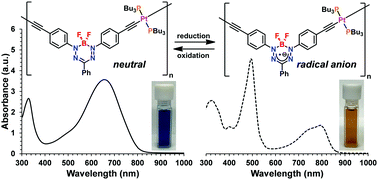A π-conjugated inorganic polymer constructed from boron difluoride formazanates and platinum(ii) diynes†
Abstract
The first example of a π-conjugated polymer incorporating boron difluoride (BF2) formazanates is introduced. The film-forming properties, controllable reduction chemistry, and low optical band gap (ca. 1.4 eV) of the polymer make it an excellent candidate for use as a light-harvesting n-type semiconductor in organic electronics. Comparison of the polymer to model compounds confirmed that its unique optoelectronic properties can be directly attributed to the presence of the BF2 formazanate repeat unit and that the [Pt(PBu3)2]2+ unit must also be present to achieve the narrow band gaps observed.

- This article is part of the themed collection: 2018 Emerging Investigators


 Please wait while we load your content...
Please wait while we load your content...